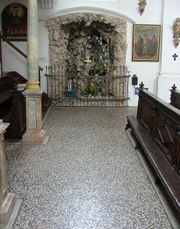Difference between revisions of "Terrazzo"
m (Text replace - "\[http:\/\/cameo\.mfa\.org\/materials\/fullrecord\.asp\?name=([^\s]+)\s(.*)\]" to "$2") |
|||
| (4 intermediate revisions by the same user not shown) | |||
| Line 1: | Line 1: | ||
| + | [[File:Terrazzo floor.jpg|thumb|Terrazzo floor, Maria Schnee church. Credit: Richard Mayer]] | ||
== Description == | == Description == | ||
| − | A durable floor surface composed of granulated stone set in a cement or a synthetic resin matrix. Based on ancient mosaic methods, terrazzo was introduced in the United States in the late 1890s. However, it was rarely used until 1919, when a method was developed to subdivide the floor using metal divider strips ([[brass|brass]], [[copper|copper]], [[nickel|nickel]], [[silver|silver]], or [[zinc|zinc]]). This method minimized cracking due to expansion or settling. It also added numerous decorative design options. By the late 1930s, terrazzo was a popular flooring for high traffic areas such as hospitals, bus stations, airports and schools. Terrazzo floors are typically made of 30% [[portland%20cement|portland cement]] mixed with 70% stone chips, such as [[marble|marble]], [[onyx|onyx]], [[travertine|travertine]], or [[serpentine|serpentine]]. Occasionally coarse particles of aluminum oxide ([[Alundum | + | A durable floor surface composed of granulated stone set in a cement or a synthetic resin matrix. Based on ancient mosaic methods, terrazzo was introduced in the United States in the late 1890s. However, it was rarely used until 1919, when a method was developed to subdivide the floor using metal divider strips ([[brass|brass]], [[copper|copper]], [[nickel|nickel]], [[silver|silver]], or [[zinc|zinc]]). This method minimized cracking due to expansion or settling. It also added numerous decorative design options. By the late 1930s, terrazzo was a popular flooring for high traffic areas such as hospitals, bus stations, airports and schools. Terrazzo floors are typically made of 30% [[portland%20cement|portland cement]] mixed with 70% stone chips, such as [[marble|marble]], [[onyx|onyx]], [[travertine|travertine]], or [[serpentine|serpentine]]. Occasionally coarse particles of aluminum oxide ([[Alundum|Alundum®]] or [[Carborundum|Carborundum]]) were added for texture. |
== Synonyms and Related Terms == | == Synonyms and Related Terms == | ||
| Line 7: | Line 8: | ||
Punte; Seminato | Punte; Seminato | ||
| − | == | + | == Risks == |
Can be etched or pitted with acids and alkalis | Can be etched or pitted with acids and alkalis | ||
| − | == | + | == Resources and Citations == |
| − | + | * Walker Johnson, "Terrazzo", in ''Twentieth-Century Building Materials'', T. Jester (ed.), McGraw-Hill: New York, 1995. | |
| − | + | * Web Link: [http://www.ntma.com National Terrazzo and Mosaic Association] | |
* Thomas C. Jester (ed.), ''Twentieth-Century Building Materials'', McGraw-Hill Companies, Washington DC, 1995 | * Thomas C. Jester (ed.), ''Twentieth-Century Building Materials'', McGraw-Hill Companies, Washington DC, 1995 | ||
Latest revision as of 07:46, 13 August 2020
Description
A durable floor surface composed of granulated stone set in a cement or a synthetic resin matrix. Based on ancient mosaic methods, terrazzo was introduced in the United States in the late 1890s. However, it was rarely used until 1919, when a method was developed to subdivide the floor using metal divider strips (Brass, Copper, Nickel, Silver, or Zinc). This method minimized cracking due to expansion or settling. It also added numerous decorative design options. By the late 1930s, terrazzo was a popular flooring for high traffic areas such as hospitals, bus stations, airports and schools. Terrazzo floors are typically made of 30% Portland cement mixed with 70% stone chips, such as Marble, Onyx, Travertine, or Serpentine. Occasionally coarse particles of aluminum oxide (Alundum® or Carborundum) were added for texture.
Synonyms and Related Terms
Punte; Seminato
Risks
Can be etched or pitted with acids and alkalis
Resources and Citations
- Walker Johnson, "Terrazzo", in Twentieth-Century Building Materials, T. Jester (ed.), McGraw-Hill: New York, 1995.
- Web Link: National Terrazzo and Mosaic Association
- Thomas C. Jester (ed.), Twentieth-Century Building Materials, McGraw-Hill Companies, Washington DC, 1995
- Anne Grimmer, Glossary of Building Stone Terms, A Glossary of Historic Masonry Deterioration Problems and Preservation Treatments, National Park Service, Washington DC, 1984
- G.S.Brady, Materials Handbook, McGraw-Hill Book Co., New York, 1971
- The American Heritage Dictionary or Encarta, via Microsoft Bookshelf 98, Microsoft Corp., 1998
